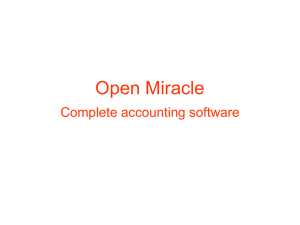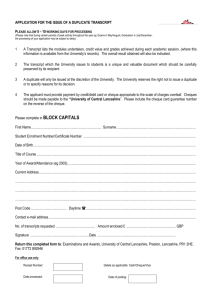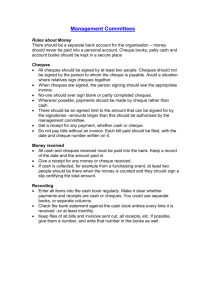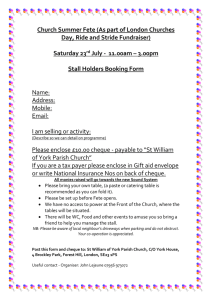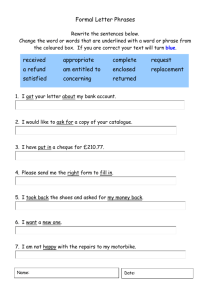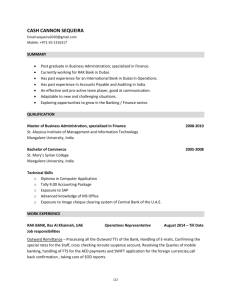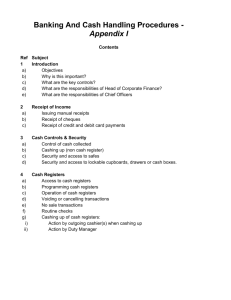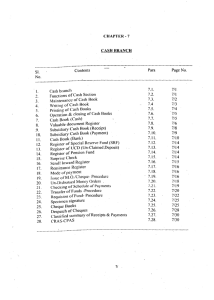CPWA 1. CASH BOOK NO…………….
advertisement
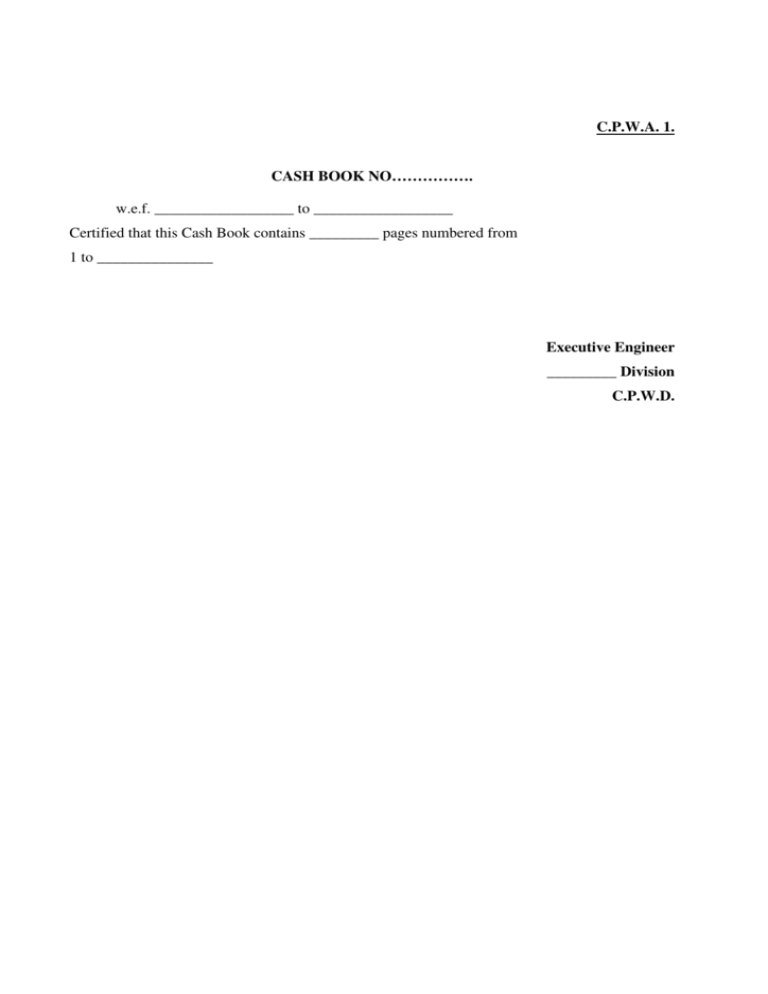
C.P.W.A. 1. CASH BOOK NO……………. w.e.f. __________________ to __________________ Certified that this Cash Book contains _________ pages numbered from 1 to _______________ Executive Engineer _________ Division C.P.W.D. C.P.W.A. I. (I) CASH BOOK (Central Public Works Accounts Code, Paragraph 6.5.1, 6.6.1 to 6.6.7) 1. The Cash Book contains two money columns headed (1) “Cash” and (2) “Bank” on the payment side to distinguish between payments made by cheques from those made out of the cash in chest. When, however, a cheque is drawn to replenish, the chest, its number and amount should be entered on the payment side in the “Bank” Columns Nos. 10 and 11, and the amount only on the receipt side as “Cash” from “Bank” in the single Cash column No. 4. The amount of a cancelled cheque should be shown by a special write-back entry as a minus figure on the payment side in the “Bank” column. A counter-reference should be given in the cash book, against the original to the second entry of the cheque. The issue of a new cheque in lieu of a time-expired or lost cheque should be entered on the date of issue in red ink in the cash book but not in the column for payment, a counter reference being given in either case against the original entry in the cash book. 2. Every entry must be concise. The date, the number of voucher and the name of the work, and such a brief narration as will indicate unmistakably the nature of transaction must be entered against each item. The amount debitable or creditable to each separate work, head of account or contractor or other person should be entered separately and the amounts to be posted by the divisional office into the Abstract Book or Schedules of account under each prescribed head of account should be distinctly brought out opposite the entries in columns 5 and 12 headed “Classification of Receipts” and “Classification of Charges”. No receipt or payment other than of “cash” as defined in paragraph 6.1.1 of the Code, should be entered in the cash book. A deduction made at the time of payment, creditable to a work or head of account other than that to which the payment itself is debitable, should, however, be entered on the receipt side of the cash book. 3. The transaction relating to the realization of miscellaneous cash receipts by a subordinate and their remittances directly into bank is incorporated in the cash book by the next superior officer having a cash book on receipt of the receipted challan of the bank from the subordinate, as prescribed in paragraph 6.3.4 of the C.P.W.A. 4. It is a serious irregularity to draw cheques and deposit them in the cash chest at the close of the year for purpose of showing the full amount of grant as utilized or to keep the cash book open after the 31st of March and make disbursements in April entering them in the cash book as having been made in March. 5. Acknowledgements of payments should as far as possible, be taken at the time of payment and on one of the printed forms prescribed for the purpose. They should be numbered consecutively in a separate series for each month and the serial number of each voucher should be entered in the cash book as soon as the payment transaction is entered in it. 6. When an imprest is first given the fact should be noted in red ink in the cash book of the Disbursing officer giving it, in the column “To whom paid”, but the amount should not be entered as an actual payment as it will still form a portion of the cash book balance of the Disbursing Officer making the advance. If, however, a cheque is drawn, its amount must be shown on both sides of the cash book, vide Note 1. Any subsequent increases or decreases in the amount should be noted, similarly the increases on the payment side and the decreases on the receipt side. 7. In posting transactions from imprest accounts the recouping Disbursing Officer should enter in his cash book only the total for each work or head of account as brought out in the abstract, which should be prepared in his own office, on the reverse of the imprest account. 8. All payments must be debited at once to the work or service on account of which they are made. Money advanced to a subordinate for disbursement to labourers, etc., at a distance should be noted in the cash book in red ink as a temporary advance, in the manner followed when regular imprests are first made; and when the subordinate returns the duly certified muster rolls, etc. with the unpaid wages, if any, the amounts actually paid should be debited to the works or services concerned, the amount unpaid being returned into the cash balance. 9. When an advance on transfer is made to a Government servant from the cash in the hands of the Disbursing Officer pending recoupment when the bill is encashed subsequently, the amount thus advanced should not be entered as a final transaction in the cash book but recorded as a temporary advance so that the amount may continue to form part of cash balance for which the Disbursing Officer is responsible. 10. The procedure for dealing with time-expired, cancelled and lost cheques is prescribed in paragraphs 6.2.10 to 6.2.13 of the code. 11. The cash balance at the end of the month should be detailed thus in a note at foot of the cash book : Rs. Cash in chest Imprest with Mr.R.Johnson Temporary Advance with Mr. Abdul Raheem Total cash balance as above 700 1,000 500 2,200 (Rupees Two thousand two hundred only) 12. Cash books should have their pages machine-numbered. As far as possible, no lines should be left blank, but if any space on a page of the cash book has to be left blank owing to the whole of the other page of the same folio being written up completely a diagonal line should be drawn to cancel the blank space, so that it may not be possible to make any subsequent entries therein. Interpolation of entries should be avoided as far as possible, but when it becomes necessary to make any entries between two ruled lines or to make any additions to, or interpolations between, entries already made, such additions should invariably be attested by the dated initials of the Disbursing Officer. FORM 1 (P.W.A.) (Referred to in paragraphs 6.6.1 to 6.6.7 of CPWA Code) CASH BOOK OF ……………….FOR THE MONTH OF ……………..20…. ……………………Division Receipt side Payment Side Payment Date of Receipt No.of Voucher or Receipt From whom received etc. 1 2 3 Amount (Cash) Classification of Receipt Date of Payment No.of Voucher To whom paid etc. Cash 4 5 6 7 8 9 Bank Cheque No. (with No. of Amount Cheque Book) 10 11 Classification of Charges 12 FORM 1 A REGISTER OF CHEQUES ETC. RECEIVED AND ADJUSTED (Referred to paragraph 6.3.2) Notes to be printed on the fly-leaf 1. Cheques of private individuals received in payment of Government dues should initially be entered in this register in accordance with the instructions in para 6.3.2 2. This Register is to be treated as a subsidiary Cash Book and for this reason the pages of the Register should be machine-numbered. 3. Only the daily totals of receipts and remittances should be entered in the Cash Book. Serial No. Date of receipt From whom received Name of the Bank, Cheque No. and date Amount On what account to be credited Date of despatch to the bank 1 2 3 4 5 6 7 Date of Bank Scroll in which credit traced 8 Divisional Officer’s initials Remarks 9 10
